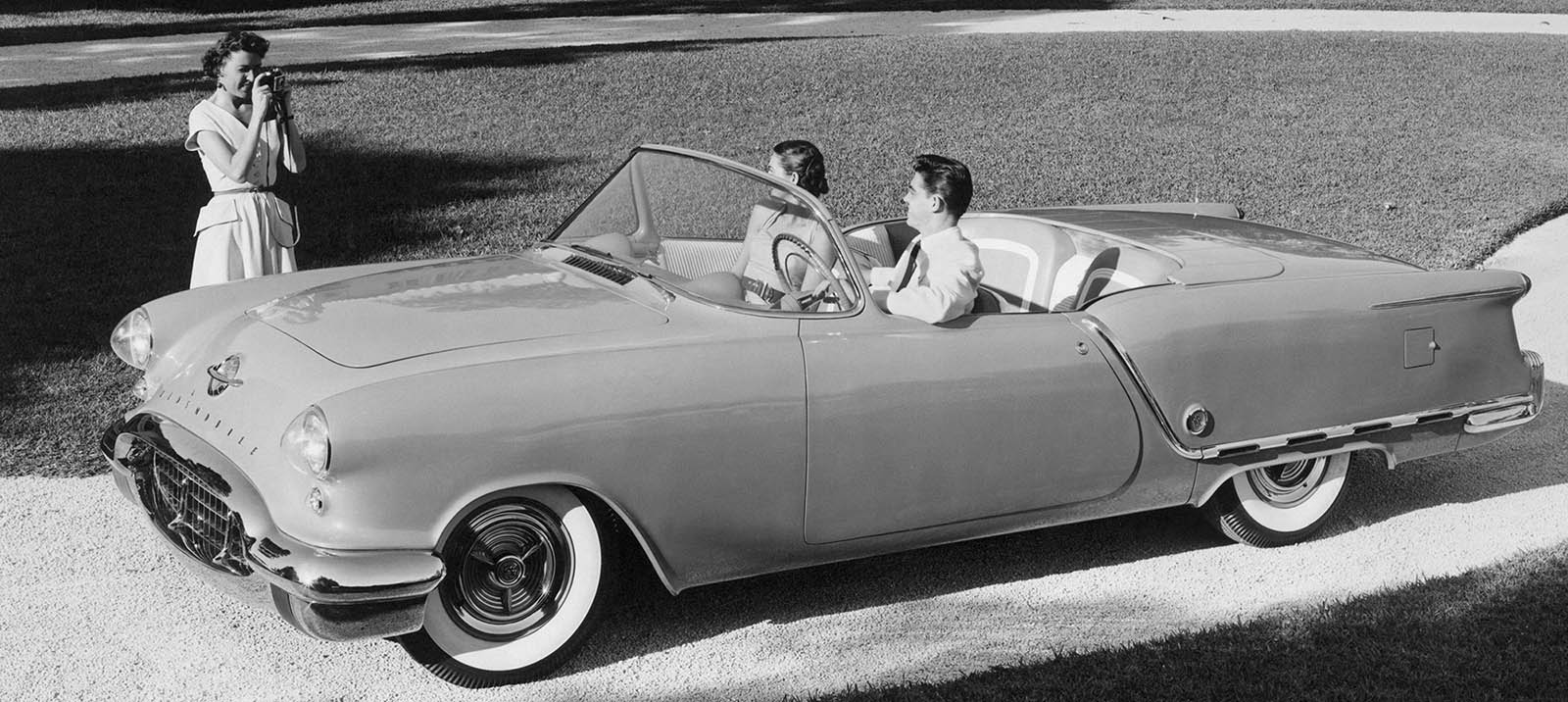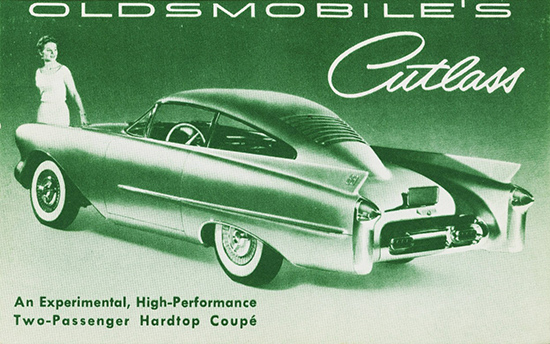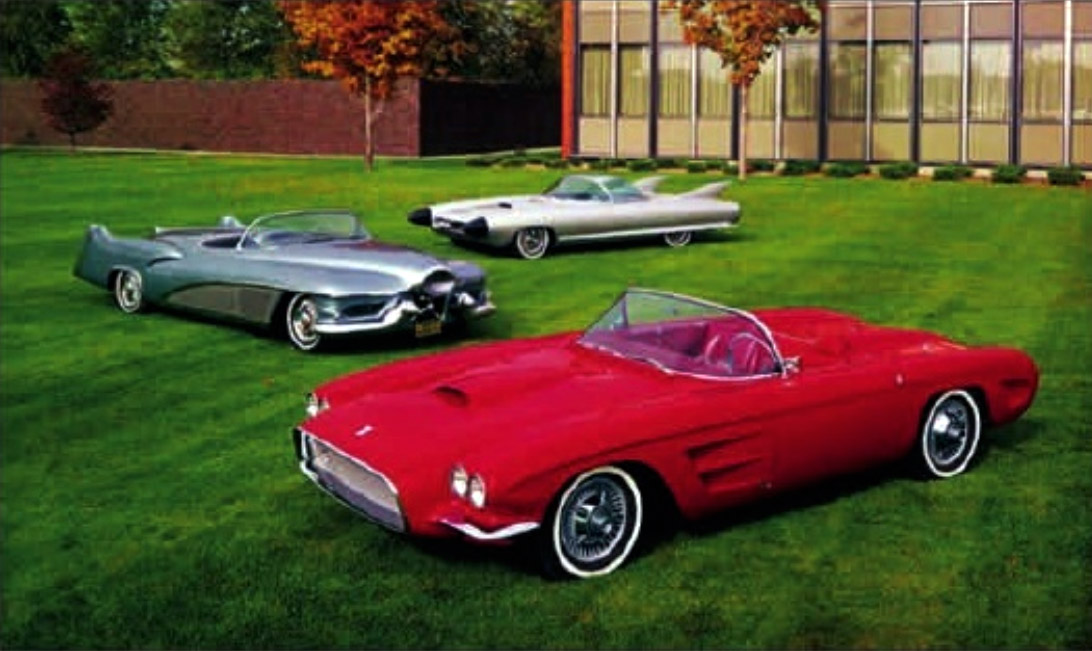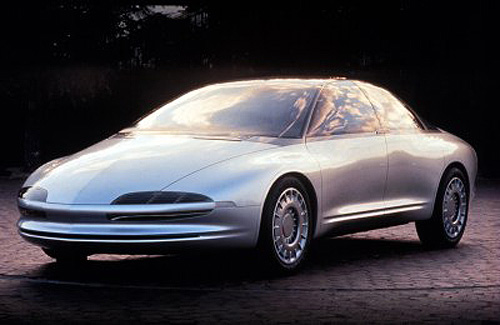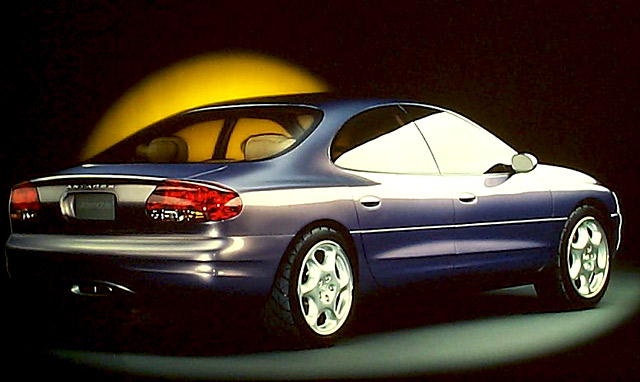Concept Cars showcased radical ideas and introduced new concepts.
Some may have been close to, or somewhat along the same lines as a future model.
1953 Oldsmobile Starfire X-P Rocket
1954 Oldsmobile Cutlass Concept
The 1954 Oldsmobile Cutlass Concept took its name from the military Chance-Vought Cutlass, a Navy fighter plane. Aviation theme was prevalent throughout the Cutlass. Instrumentation resembled aircraft instruments. The underside of the front fenders was wide open and was perforated to permit exhaust of engine heat. The Cutlass had no outside trunk lid to open. Access to the luggage compartment was reached from inside the car. The entire body was of reinforced plastic mounted on a 110-inch wheelbase chassis with a 51.5-inch road height. Other features included a combination bumper-grille, swivel seats and copper-toned glass for screening harsh light.
The Cutlass made its debut at the 1954 GM Motorama. The body of the Cutlass was painted metallic silver with a white and copper leather interior. It was powered with a 250-horsepower advanced version of the Rocket V8 engine.
1954 Oldsmobile F-88 Concept
F-88 was a pet project of Harley Earl. Bill Mitchell, Ken Pickering and Zora Arkus-Duntov were a few of the engineers involved in this project. Designed during 1952-53, around the same time as the first Motorama Corvette. The final design was done in the main Oldsmobile studio under the direction of Art Ross.
Its fiberglass body sat on an early Chevrolet Corvette chassis. The F-88 was powered with a hotted up V8 from a '54 Olds Super 88 that produced a reported 250HP. A 4-speed Hydra-Matic transmission was used with a Corvette rear axle.
Chevrolet, which produced more GM products than other divisions, convinced GM's board of directors to cut the Olds project so the F-88 never went into production.
There are many stories on how many F-88s were built, but only one survives today and was auctioned at the 2005 Barrett Jackson Classic Car Auction for $3,240,000.
1954-55 Oldsmobile F-88 Concept Variants
Even while the '54 F-88 was on tour, Oldsmobile and Harley Earl were tweaking the F-88 as they expected it to become Olds' flagship performance car. Chevy's Corvette would be considered the entry level, and owners could move up to Olds when they wanted more luxury and performance. Version two had more cut out wheel wells, something Harley Earl was experimenting with. The rear was cleaned up as well (not shown in the pictures here). There was a removable fiberglass top, similar to the '56 Corvette. In a response to the '55 Corvette's adoption of the 225HP V8, Earl commissioned the engine for the 2nd prototype to have a supercharged motor with 370 HP.
1955 Oldsmobile 88 Delta Concept
Featured teardrop wheel wells, stacked headlights, two tone blue paint, and only stood 53.1 inches tall. It was advertised to have "Supersonic Shape". The wide ovals housing the headlamps also included scoops to cool the front drum brakes. The 88 Delta was equipped with swivel bucket seats up front. Tires were mounted on 6 lug wheels, exposed brake drums had concentric cooling fins and exposed acorn style lug nuts.
1957 Oldsmobile F-88 Concept Mark II
In 1957, Harley Earl unveiled a "new" F-88, still trying to convince GM to offer the car as an upscale Corvette. Many styling cues would find their way to the '58 Corvette.
The front prominently displayed "OLDSMOBILE" in large letters.
The interior was upholstered in light metallic blue, the steering wheel was modernized, but otherwise it was much the same as the 1954 F-88 - showing how timeless the original design had been.
1959 Oldsmobile F-88 Concept Mark III
Chevrolet, which produced more GM products than other divisions, convinced GM's board of directors to cut the Olds project so the F-88 never went into production. Harley Earl was stunned, and commissioned a red F-88 for himself as a sign of dissatisfaction with the decision - and began driving it as his personal car.
Later, he took the '59 as his personal car (known as Mr.Earl's Private Rocket) when he retired, and he drove it until his death in 1969. The car was returned to GM and ordered to be destroyed sometime in the mid-70s.
This car had a retractable hardtop, a 6 speed transmission which was actually a 3 speed Hydra-Matic with overdrive. The trans was frame mounted at the rear with swing axles. It had fuel injection, but apparently was troublesome and was refitted with a carburetor and a different transmission later in its life.
1962 Oldsmobile X-215
X-215 featured a full-width concave grille, within the concavity are 2 headlamps and 2 long range driving lamps. The bumper sweeps around the body and appears to float in front of the grille. The X-215 is finished in Firefrost silver, with a narrow black stripe down the center between the twin rows of louvers on its hood.
A glass-fiber tonneau cover, incorporating an airfoil-section roll bar, covers the rear seat and sweeps down into the cockpit to merge with a special center console.
Black leather bucket seats face a new instrument cluster designed around 2 large dials, the left one a spedometer, and the right a single dial including the four standard engine instruments. Smaller dials flank these, on the left a tach and on the right a pressure gauge for the X-215's turbo-charged engine.
1966 Oldsmobile Toronado Concept
1967 Oldsmobile Thor Concept
In 1967, Ghia helped GM's Bill Mitchell spice up the Oldsmobile Toronado. However, Toronado debuted in 1966 and this one-off concept came in 1967. Perhaps it pointed the way in which the redesigned Toronado was supposed to go (it was built on a FWD Toronado frame). There were rumors that it was destroyed, but last we know of Olds Thor, was that it ended up in DeTomaso factory museum from which it departed in 2004.
1968 Oldsmobile Toronado XP-866
1970 Oldsmobile XP-888-GT
1971 Oldsmobile Toronado Styling Mock-Ups
1977 Oldsmobile Mirage J-Coupe model
This photo was originally posted on Dean's Garage (website), it was one slide that was part of a slideshow likely shown in 1975 as a preview of upcoming 1977 Oldsmobile models.
1986 Oldsmobile Incas
Two front 'doors' that opened along with the front 'dome', rear doors were gull wing. Steering wheel was inspired by an aircraft joystick as research suggested new car buyers at the time, who had grown up with videogames might prefer it, to a traditional steering wheel. The joystick only required a 90 degree turn to fully turn the wheels in one direction.
1989 Oldsmobile Aerotech 2
Research gleaned from the Aerotech which rewrote record books in August 1987 provided inspiration for the Aerotech II. Making its debut at the 1989 North American International Auto Show in Detroit, the aim of the concept was to apply the low drag benefits from the Aerotech to a 4 passenger sports coupe.
Comfort and everyday practicality were top priorities. The extra interior volume provided by the extended roofline is readily accessible through a pair of tinted-glass hatches that lift upward from each side of the car.
Aerotech II included inflatable restraints, color visual information center, navigation system by CD, digital heads up display, ceiling mounted holographic device projected a red 3-D warning on the rear glass when brakes applied, 230hp 2.3L engine with electronic traction control and antilock brakes.
1989 Oldsmobile Aerotech 3
The Aerotech III was a thinly disguised version of the upcoming 1990 Cutlass Supreme sedan (the coupe was first to debut in 1988). The lower cladding, previewed the 1992 Cutlass Supreme exterior freshening. Power came from a 230HP supercharged Quad 4 engine. The exterior featured experimental quartz-halogen mini-cube headlights.
The interior featured leather-trimmed seating consisting of four reclining bucket seats. There was a full-length console which ran the whole length of the interior cabin and included four built-in cupholders and a cooler in the rear. The interior also featured digital instrumentation, an obstacle detection system, and a heads-up (HUD) display.
1989 Oldsmobile Tube Car
(Aurora Concept)
Full-width tail lamps, wrap around rear windshield, frameless windows, and suicide doors. Many styling elements seen on the Tube Car were carried through to the production Oldsmobile Aurora.
1990 Oldsmobile Expression
4 wheel steering, fiberglass panels, rainsense wipers, Nintendo+VCR+TV in rear, hot & cold storage and built in vacuum.
1991 Oldsmobile Achieva Concept
(Calais replacement)
Water-fall grill, wrap around tail lights, thin window pillars for better visibility, and stand alone rear seats capable of reclining.
1992 Oldsmobile Anthem
Heads up display, driver info center with navigation, LCD roof panels that could be adjusted by passengers to adjust the opacity of the glass from clear to nearly opaque.
1995 Oldsmobile Antares
First Oldsmobile to wear the new Olds logo. Vibrant champagne blue paint. 6-spoke, 18-inch aluminum wheels. Brushed metal controls, switches and dash faceplates (which were hoped to be retained in a production car). The console contained a pop-out Guidestar navigation system. Designed for full size room in a mid-size car package. Antares was a preview of the '98 Intrigue production car, which was unveiled in 1996 as the replacement for the Cutlass Supreme.
1997 Oldsmobile Alero Concept (Alpha)
1999 Oldsmobile Recon
Completly designed by computer, re-configurable insturment panel, all wheel drive, seats with no upholstery or covering were said to be comfortable and damage resistant.
2000 Oldsmobile Profile
All wheel drive with traction control, steering wheel mounted shift buttons, smart card keyless ignition system that adjusted seat, mirror, radio, and steering wheel when activated by driver. Through voice activation, the internet, mobile phone, and vehicle data could be obtained.
2001 Olds 04
Opel Astra chassis, with body designed by Italian coachbuilder Bertone. Came with two-panel, carbon-fiber targa top that could be switched to make the Olds O4 either a closed coupe or open convertible. Also featured a retracting rear window. Rear doors were half size and suicide style. Cats-eye taillights and centrally mounted rectangular exhaust ports mounted in the rear bumper. Powered by an Opel 2.0L, turbocharged DOHC inline four-cylinder 190hp engine. Reconfigurable LCD dashboard with PDA docking port. The 'O' in the name is for oxygen, the 4 is for the number of seats.







